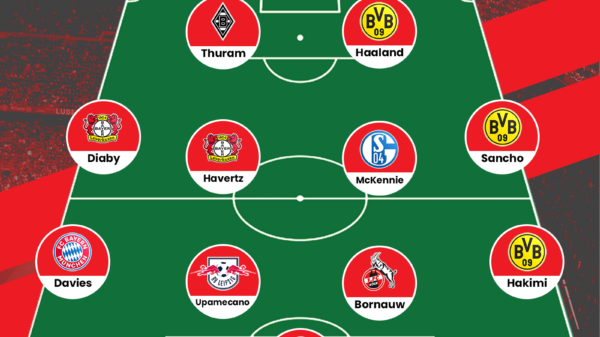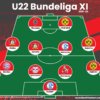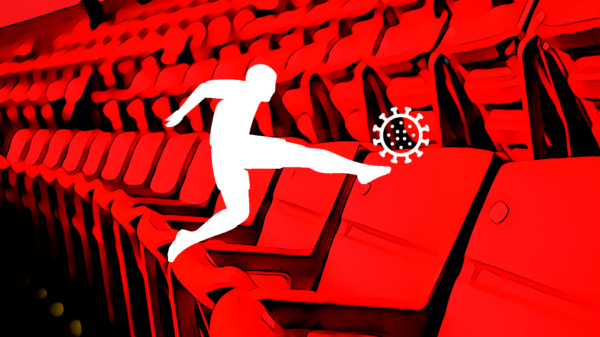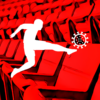Miles Olusina writes a detailed scout report about the the Borussia Monchengladbach and Germany midfielder.
For many decades now, Germany and the Bundesliga has become a factory for some of the world’s top midfielders, with world class players coming off the production line to light up the Bundesliga and star for Die Mannschaft. This has become even more common since the turn of the century as the country underwent a complete overhaul in the way in which they developed their youth. Ultimately, the production of talented youngsters increased substantially with some of the world’s greatest coming through Germany in recent years. Some of these illustrious names include Mesut Ozil, Toni Kroos, Philip Lahm and Thomas Muller to name a few. Along with these stellar footballers, a number of young, up and coming stars have made a name for themselves over the past few seasons, starring in Germany’s top sides and breaking into the national team; players such as Joshua Kimmich, Julian Weigl, Felix Passlack, Leon Goretzka and Leroy Sane are just a few of the stars to burst onto the Bundesliga scene recently.
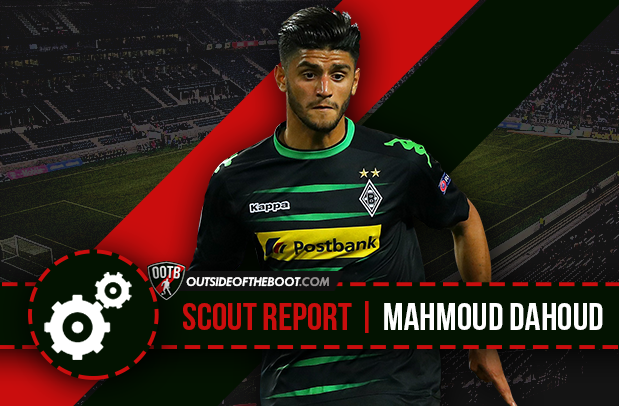
One of the most promising, albeit also one of the most unknown, is Borussia Monchengladbach’s hot young prospect, 20-year old midfielder Mahmoud Dahoud. Thoroughly impressing for his side in the no.8 role since cementing his place in the starting XI at the beginning of the 2015-16, he has shown the same quality this season, softening the blow left by the departure of Granit Xhaka in the summer.
Who is Mahmoud Dahoud?
Dahoud was born in Amuda, Syria on the 1st January 1996, moving to Germany as a young child. He was initially snapped up by Fortuna Dusseldorf but made the switch to Gladbach at the age of 14. It would be another 4 years before he made his debut for the senior side, coming on as a late substitute in a 7-0 Europa League qualifier win over FK Sarajevo on August 28th 2014. Before then, he had been plying his trade in the U17 and U19 sides respectively, standing out as the key player for his side.
Talent Radar Accolades
- 100 Best Young Players to Watch in 2017
- 100 Best Young Players to Watch in 2016
- 2016-17 Bundesliga Team of the Season
- 2015-16 Bundesliga Team of the Season
Appearing sporadically at first, Dahoud became a mainstay in the side in the early stages of the 2015/16 season following the appointment of Andre Schubert. His first goal followed shortly after on the 23rd September 2015 in a 4-2 win over Augsburg, the first of 5 he would score in the Bundesliga. He slotted in almost seamlessly into Schubert’s 4-4-2 system, combining well with then star man Granit Xhaka and helping the club to a fourth placed finish and a Champions League spot. As well as impressing in the Champions League group stages that season, he proved to be one of the breakout stars in the Bundesliga and finished the season with 9 assists to add to his 5 goals in 32 league appearances.
What is his Style of Play?
One of the things that makes Dahoud such a highly touted prospect is the fact that he is able to function in multiple roles as a midfielder, a trait which is rare in midfielders of his age and suggests a high level of football intelligence. He has shown capabilities as a ball winner, averaging 2.9 tackles and 2.3 interceptions per 90 minutes in the 2015/16 season. However, he tends to excel primarily when functioning as box-to-box midfielder or as a deep-lying playmaker and has also shown qualities that could make him into a quality no.6.
In many of the games he has played he has displayed a great passing range and a high football IQ in terms of his movement off the ball and his vision. At just 20 years of age, he is already displaying multiple attributes that could make him a world class midfielder in the next few years or so. He has a style similar to Man City midfielder Ilkay Gundogan, combining the deep lying playmaker role with a box to box one and proving to be a good ball carrier in attacking transitions for his side.
What are his strengths?
Listing all his strengths is quite difficult as he has so many; one asset of his which stands out in particular is his incredible close control and dribbling ability. He shows all the characteristics of a so called ‘needle player’, a player with great ball control and an ability to function in compact and crowded areas of the field almost as well as in spacious areas of the pitch. It serves a great purpose when in the crowded midfield area as it allows him to evade challenges and keep possession for his side, making him a very press resistant player which is essential in the build-up phase as the team aim to keep possession and build attacks.
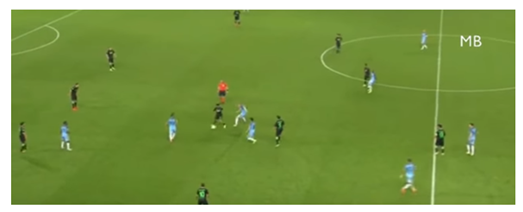
He shows this here in a Champions League clash against Man City when he receives the ball amidst a crowd of Man City players. With City clearly having the overload, it would appear to be a certainty that they would use it to their advantage and dispossess the young German. However, he skips past all three challenges and his side keep possession. This was crucial as they were still in the build-up phase; had possession been lost there, City would most likely have capitalized on this as the Gladbach centre-back would have been forced to vacate his position within the defensive line, creating a space within the back 4 which would have allowed for a diagonal run from Sterling in behind their defensive line.
He does well initially to shield the ball from Kevin de Bruyne, something he does very well despite his relatively average height of 5’9 and skinny frame. He then pauses momentarily, waiting for Aguero to commit and dive in for the tackle before changing pace and quickly moving the ball away from the Argentinian with two touches. Had he not taken the second touch, Gundogan would have had the opportunity to make a challenge, however his extra touch gave him the added control of the ball he needed as it meant the ball did not go astray.
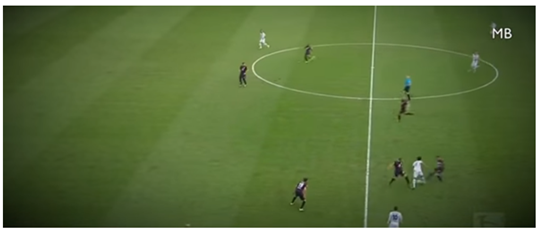
He showed this quality again in man of the match performance against Frankfurt, but this time in a more advanced position when in attacking transition for his side. The ball is played to him in anticipation of a potential counter attack; however he slows down as there is no direct route to goal or viable vertical option. Two defenders come rushing in aiming to regain possession but he is quick to sense this as a result of his advanced awareness and moves the ball in between them, shifting his body from one side to the other before the opposition players are able steal possession.
His ability to maintain control of the ball in tight spaces is an incredibly powerful weapon when attempting to break down deep defences, as his Gladbach side have had to endure for much of this season when looking to dominate the game. He does not often lay on the defence splitting through ball, although he is capable, but instead primarily occupies a slightly withdrawn role when his side are in the final third to assist with the circulation of the ball and allow for pressure relief when necessary if possession needs to be recycled.

His ability to read the game and function in such a multitude of roles is indicative of his incredible intelligence for a player of his age, another one of his biggest strengths. His movement off the ball as well as his decision making on it is particularly impressive and was on show in their home game against Barcelona, where he put on a wonderful performance and ended the match with an assist.
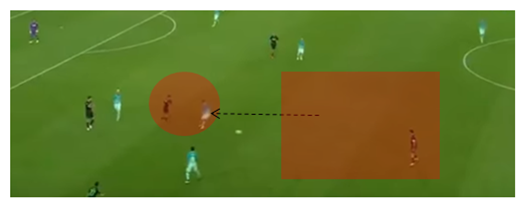
He shows his awareness and his ability to create space for his teammates by creating holes in the opposition defence in this image when drops into the 6 space to receive possession from his goalkeeper Yann Sommer. Aware of the potential danger of giving him an excess amount of space, Busquets pushes up from his position in front of the Barca back 4 to put pressure on the Gladbach midfielder to stop play from progressing into the next phase of possession.
Dahoud’s task is made more difficult by the fact that he receives the ball with his back to goal, therefore having a limited field of view and that his only vertical passing option is being cover shadowed by Busquets. He maneuvers his way out of the pressure expertly, first by dropping deeper between the lines to create more space for his teammate further ahead, then by taking advantage of Busquets’ man orientation to open up the passing lane for his teammate. He runs horizontally, well aware that Busquets would track him which had the knock on effect of giving his teammate more freedom to receive the ball as he was no longer being cover shadowed.
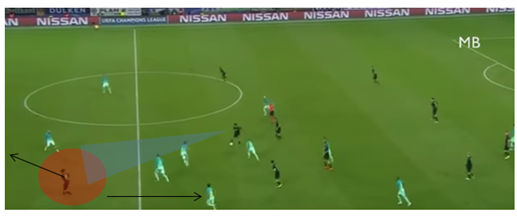
He displays wonderful vision in this next scenario as his side win possession and look to exploit the Barca re-organization in defensive transition. His speed of thought combined with his vision is exemplary in this clip as he opens up his body and immediately plays the ball to Johnson in the RB-CB zone. A less tactically intelligent and opportunistic player would have gone for the safer, horizontal pass however; he showed his willingness to play a riskier pass when necessary. He shows in this move that as well as being an effective ball carrier for his side in attacking transitions, he is capable of laying on key passes and exploiting gaps that appear within a side’s defensive structure once they have lost possession.
What are his weaknesses?
It is a testament to his incredible ability and maturity as a player that finding a weakness was so difficult. He appears to have a completeness about him despite his youth and makes up for his physical deficiencies with his technique and tactical intelligence. That said, he can occasionally be guilty of taking too many touches and overplaying at times; sometimes in areas which could lead to potentially dangerous situations for his side. However, he cannot be entirely blamed for this as his team do sometimes struggle to create adequate positional structures in relation to the ball and their teammates, which occasionally leads to a player like Dahoud, who is fond of roaming and searching for possession, being isolated.
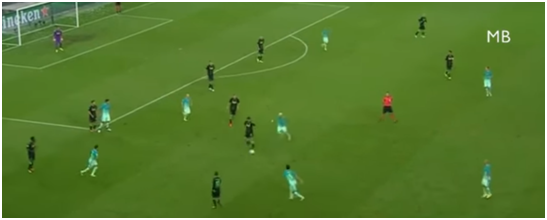
He is in possession here with one Barca player behind him aiming to win the ball and Busquets trying to maintain access to Hazard. With few options ahead of him, he hesitates, looking for another pass instead of playing a one-two with his teammate and is dispossessed. Had his team been more underloaded after the changeover in possession, the consequences could have been much more severe.
Read all our scout reports here.
- Scout Report: Marcus Thuram | Gladbach’s attacking sensation - July 17, 2020
- Tactical Philosophy: Paulo Fonseca - May 28, 2020
- Maurizio Sarri at Chelsea: Tactical Approach & Key Players - September 5, 2018























































